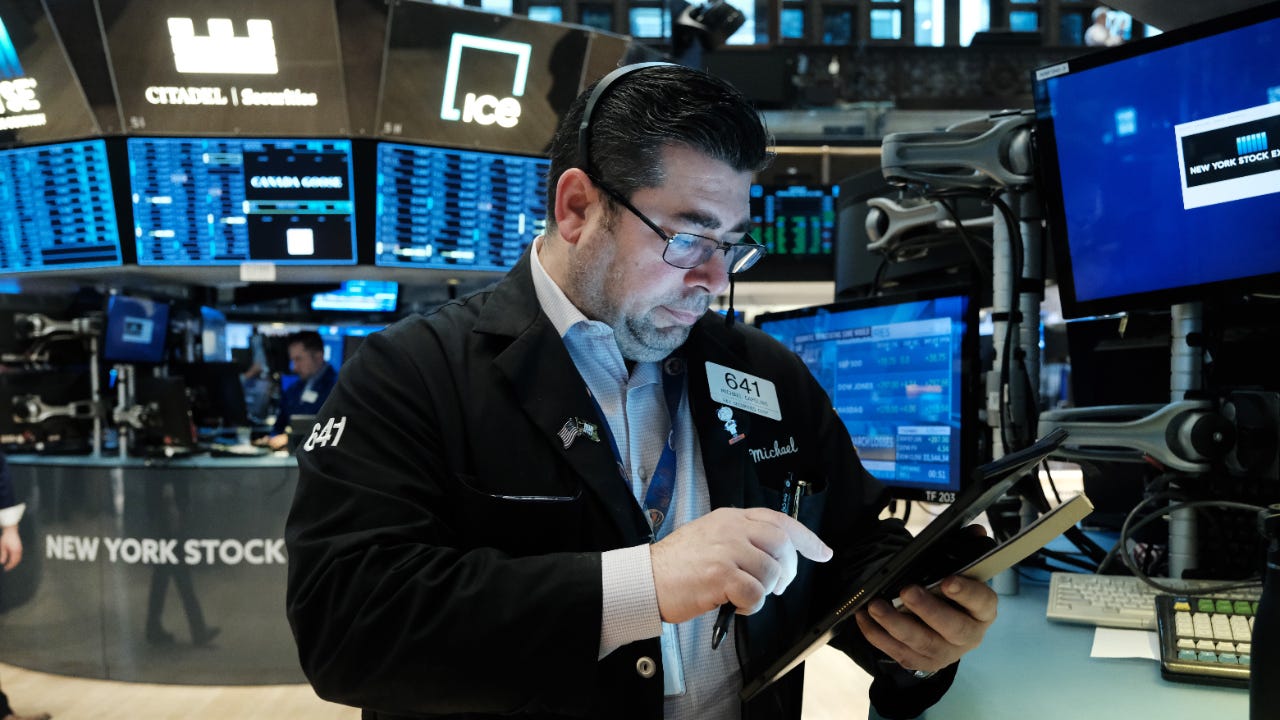Survey: Market analysts see stocks jumping more than 11% over the coming year

It may have been a rough start to 2022, but top market watchers still expect stocks to climb over the coming year, according to a Bankrate survey. The First-Quarter Market Mavens survey reveals that analysts anticipate the S&P 500 will rise more than 11 percent over the next 12 months. It’s the sixth straight quarter that the survey has predicted a rise in the index.
In fact, all but two analysts who offered estimates for the index saw it rising over the coming year. Overall, these analysts projected the S&P 500 to reach 4,746 — up from 4,259.52 when the survey closed on March 10, 2022. Despite this optimism over the next year, analysts became much more pessimistic about performance over the next five years than they have been in recent quarterly surveys.
“Most investing pros are maintaining their faith in stocks, predicting a generally solid showing from here over the next year,” says Mark Hamrick, Bankrate’s senior economic analyst. “Between high inflation, the Federal Reserve’s plans to raise interest rates and conflict in Europe, much has changed both recently and over the past year or so.”
Forecasts and analysis:
This article is one in a series discussing the results of Bankrate’s Market Mavens first-quarter survey:
- Market analysts see stocks jumping more than 11 percent over the coming year
- Experts forecast Treasury yields to push even higher over next 12 months
- Pros say these investments are among the top hedges in battle against high inflation
- Best ways to invest $10,000 in 2022, according to experts
Stocks expected to climb more than 11 percent in the coming year
After a strong 2021 for stocks, the market decided to sell off as 2022 began. This year, the market quickly entered correction territory, defined as falling more than 10 percent from a recent high. This decline was something that Bankrate’s fourth-quarter survey suggested was imminent. Stocks in higher-growth sectors were hit even earlier, as these sensitive areas responded more quickly to warnings from the Federal Reserve that it would remove monetary stimulus.
With stocks already down to start the year, the survey’s respondents were a little more optimistic about future returns from here, at least relative to recent surveys. They see the market rising more than 11 percent over the coming 12 months, compared to 8 percent projected gains in the fourth-quarter survey, 9 percent in the third quarter and 8.7 percent in the second quarter.
Only two of 16 analysts surveyed expect the S&P to decline from 4,259.52, where it sat at the end of the survey period. Even those pessimistic expectations were modest, estimating downside of just 2 to 6 percent. At the high end, one analyst projected the S&P to reach 5,250 — a return of more than 23 percent. The average estimate was for the S&P 500 to hit 4,746 in the next year.
“Investors have been through a lot over the past couple of years and even just the past few weeks,” Hamrick says. “More recent declines in the stock market are a reminder that things can turn on a dime, testing risk tolerance, faith in previous asset allocations and overall assumptions, which may or may not be useful in the intermediate term.”
Analysts are much less optimistic about five-year returns
Surprisingly, despite their increasing optimism over the next year, market watchers expect returns over the next half-decade to be lower than historical norms, according to the Bankrate survey. Here’s how the results break down:
- About 69 percent of respondents expect the market to perform below their historical average over the next five years.
- Just 19 percent anticipate returns will be in line with historical averages.
- A mere 13 percent or so say returns will be higher than historical returns.
The results were the most pessimistic that they’ve been in the last four quarters.
The rationales varied widely, as did expectations, with at least one analyst expecting a recession while another expects a post-pandemic boom. But many respondents pointed to high stock valuations, higher interest rates and global conflict as key reasons for their pessimism.
“The current geopolitical environment, combined with an end to ultra-accommodative monetary policy, should result in lower returns moving forward,” says Brian Price, head of investment management, Commonwealth Financial Network. “Valuations certainly look much more reasonable than they did at the end of 2021, but I think there are longer-term challenges that could cap the upside of market returns over the next few years.”
Patrick J. O’Hare, chief market analyst at Briefing.com, also expects lower-than-average gains. “Ideally, there should be a normalization of interest rates over the next five years that will supplant the mostly abnormally low interest rates that have been seen for most of the previous five years,” he says. “That should create constraints for earnings growth that will slow the pace of multiple expansion.”
And valuations played a role for analysts who expected subpar gains going forward.
“The last five and 10 years the equity returns have been above historic averages,” says Clark A. Kendall, president and CEO, Kendall Capital Management. “To come back to historical norms we need a period of time below historical averages.”
One of the handful who expect above-average returns over the next decade includes James Iuorio, managing director at TJM Institutional Services. “I believe there is going to be a post-pandemic economic boom,” he says.
Experts still like U.S. stocks over global equities
Should you prefer U.S. stocks or their global counterparts over the next 12 months? That’s what the Bankrate survey asked its panel of experts. As they have in recent quarters, the respondents preferred American stocks:
- About 56 percent of these experts preferred U.S. stocks over that time frame.
- A full 25 percent of respondents favored global stocks.
- Nearly 19 percent said that returns would be about the same between the two.
Those numbers were broadly in line with results from last quarter’s survey, when 50 percent of respondents liked U.S. stocks, 30 percent favored global stocks and the remaining 20 percent thought returns would be similar.
“U.S. stocks have more upside, given the overall health of household and corporate balance sheets,” says Dec Mullarkey, managing director, SLC Management. “The S&P 500’s mini correction so far this year creates a good entry for investors who have been holding back.”
Other analysts pointed to ongoing geopolitical uncertainty, valuation or interest rates to make their case.
“The current surge in commodity prices may dent the growth prospects of those international and emerging market economies that are net importers,” says the Commonwealth Financial Network’s Price, who favors U.S. stocks. “If local companies don’t have pricing power, then I would expect that their earnings per share will be under pressure in the current environment.”
“Europe’s economic growth should remain depressed, since the geopolitical tensions should take time to calm down,” says Sam Stovall, chief investment strategist, CFRA Research. He also likes U.S. stocks over the next year.
Other analysts favor global stocks because of their depressed valuations relative to U.S. stocks.
“Assuming [the Russia-Ukraine] conflict comes to an end in a way that creates some commodity price relief, European markets should bounce back sharply, all while the European Central Bank takes a conservative stance on tightening policy,” says O’Hare, from Briefing.com.
“International has more upside based on the current depressed valuations and more dovish central bank policy,” says Chris Zaccarelli, chief investment officer, Independent Advisor Alliance.
For Kendall Capital’s CEO, the case is as simple as “global markets are trading at a dramatic discount to U.S. markets.”
Value stocks remain a top pick, too
With interest rates poised to rise — typically a bad omen for growth stocks — do the market mavens prefer value or growth stocks over the next year? The preference for value stocks is as high as it’s ever been over the past year, according to our survey:
- More than 56 percent of analysts preferred value stocks over growth stocks for the next year.
- About 31 percent tapped growth stocks to outperform value stocks.
- More than 12 percent of experts see returns would be about the same over the coming year.
It was the sixth consecutive quarter that the Bankrate survey showed experts preferring value stocks over growth stocks.
Several analysts cited rising interest rates as one reason they preferred value stocks at this point in the economic cycle.
“We are in a rising interest rate environment, and typically value stocks outperform growth during this part of the market cycle,” says Kenneth Chavis IV, CFP, senior wealth manager, LourdMurray.
“Higher interest rates typically result in P/E [price-to-earnings ratio] contraction, particularly for growth stocks,” says Stovall, who favors value stocks right now.
But after a strong downturn in growth stocks in the last few months, other analysts think growth is now poised to outperform, or at least to hold its own against value stocks.
“With many growth stocks having been hit hard already on the rate-hike concerns and the wringing out of the speculative excess in 2021, we suspect growth stocks will start to find favor again versus value stocks,” says Briefing.com’s O’Hare.
“Given a favorable economic outlook, growth companies will continue to experience the earnings resilience they have shown for years,” says SLC’s Mullarkey. “I think they will continue their performance edge over value.”
“Slowing economic growth tends to be more favorable for growth stocks,” says Jeffrey Buchbinder, equity strategist, LPL Financial. “Strong earnings and stable long-term interest rates are also expected to help growth stocks, in our view.”
But Price, head of investment management at Commonwealth, sees the prospects for value and growth being more equal, since value stocks have done so well recently, relative to growth.
“Over the next year, I would expect more balanced performance between the two styles as it seems like many growth stocks have been hit too hard over the past few months,” he says. “Rising interest rates and higher-than-normal valuations justified an initial pullback, but the trade seems to have gone too far in the near term.”
Methodology
Bankrate’s first-quarter 2022 survey of stock market professionals was conducted from March 1-10 via an online poll. Survey requests were emailed to potential respondents nationwide, and responses were submitted voluntarily via a website. Responding were: Dec Mullarkey, managing director, SLC Management; Brad McMillan, chief investment officer, Commonwealth Financial Network; Brian Price, head of investment management, Commonwealth Financial Network; Jim Osman, chief vision officer, The Edge Group; Sean Bandazian, senior analyst, Cornerstone Wealth; Patrick J. O’Hare, chief market analyst, Briefing.com; Chris Zaccarelli, chief investment officer, Independent Advisor Alliance; Jeffrey Buchbinder, equity strategist, LPL Financial; James Iuorio, managing director, TJM Institutional Services; Robert A. Brusca, chief economist, FAO Economics; Joseph Kalish, chief global macro strategist, Ned Davis Research; Sam Stovall, chief investment strategist, CFRA Research; Chuck Carlson, CFA, CEO, Horizon Investment Services; Clark A. Kendall, president and CEO, Kendall Capital Management; Kenneth Chavis IV, CFP, senior wealth manager, LourdMurray; Kim Forrest, chief investment officer/founder, Bokeh Capital Partners.
Editorial Disclaimer: All investors are advised to conduct their own independent research into investment strategies before making an investment decision. In addition, investors are advised that past investment product performance is no guarantee of future price appreciation.
Why we ask for feedback Your feedback helps us improve our content and services. It takes less than a minute to complete.
Your responses are anonymous and will only be used for improving our website.






